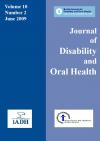Journal of Disability and Oral Health

- Cover Date:
- June 2009
- Print ISSN:
- 1470-8558
- Electronic ISSN:
- 1754-2758
- Vol:
- 10
- Issue:
- 2
Further abstracts from the IADH Congress, Santos, Brazil October 2008
V9 Promoting the oral health of pre-school children with disabilities
Sagheri D, Nunn J. O’Farrell M, Sadlier D. School of Dental Science, University of Dublin, Trinity College, Health Service Executive North-East, Dental Health Foundation Ireland darius.sagheri@dental.tcd.ie Background: In Ireland’s North Eastern (NE) region it is evident that 5-year-olds and by inference, preschool children, are experiencing more dental caries than a decade ago. The plight of preschool children with disabilities is as yet unknown. This presentation reports on the results of the baseline oral health assessment of such a group. Methods: A longitudinal study was initiated to assess and promote the oral health of preschool children with disabilities. Children with disabilities aged 0-6 years were recruited for inclusion in the intervention group, provided with a comprehensive oral health promotion programme over a 3-year period and re-assessed at 12monthly intervals. A matched control group was recruited in the South Eastern (SE) region but not provided with any oral health intervention. A team of trained dentists examined the children’s oral health status under the same standardised conditions in the two regions. Results: To date, a total of 270 children have been examined, 153 (mean age = 3.62) in the NE and 117 (mean age = 3.94) in the SE. 92 (60.1%) children in the NE and 56 (47.9%) in the SE have been caries-free. In each region, five children had at least one fissure sealant on a primary or permanent tooth, while 86 (56.2%) children in the NE and 34 (29%) in the SE qualified for referral to a dental hygienist. Discussion/Conclusion: The present data make transparent the oral health status of a potentially high-risk group of children, who do not usually come within the remit of the public dental services in Ireland. s (randomised-control-trial). It is evidence-grade V we stick to: assessment of experts, associative observations, descriptive presentations and subjective satisfaction. Our outcome is high. The schools give us access and all involved; children, teachers and educators highly value our work. All of them give us positive feed back for our behavioural approach. Of course dental treatment and fluoridation, which we encourage, play an important part as well. Conclusions: Kids with disabilities need our special care. This can be performed equitably, meeting their demands. The emotional approach is the key to behaviour forming. It is also the professionals who need more motivation, new ideas and encouragement. Want to see how it works? Join the next presentation!
Coping with a facial disfigurement – a multiprofessional network strategy
Bitte A, Nyberg J, Bergendal B, Gustafsson-Bonnier K. Mun-H-CenterSweden ,Department of Reconstructive Plastic Surgery, Karolinska University Hospital, Stockhom , Institute of Postgraduate Dental Education, Jönköping , Habilitation services Stockholm County Council, Stockholm, Sweden bitte.ahlborg@vgregion.se
Although most diagnoses that include facial disfigurement have been known for a long time, the complex of problems associated with a deviant facial appearance has not yielded a substantial number of reports in the literature for specialists. In 1999, a Swedish network for psychosocial support for people with craniofacial disorders was formed, aiming to increase the knowledge among professionals in health care and other groups in our society about living with facial disfigurement. The members of the network represent different professions all working in teams or centres for rare facial disorders. This presentation exemplifies possible ways to inform various target groups in order to increase the knowledge about persons with facial anomalies. Until now the network has organised well represented national congresses with a variety of themes. Reports have been published in journals of professional oganisations as well as in newspapers and magazines. The work has also resulted in initiating the establishment of two Swedish patient organisations. The network has recently published a book entitled Another Face with interviews and unique photographs of young persons with deviant facial appearance, in order to describe their coping strategies in everyday life. In our society, where appearance is an important determinant of social acceptability, the Swedish network sees no end of working tasks and will continue its mission to counteract prejudice against persons with deviant appearance.
- Article Price
- £15.00
- Institution Article Price
- £
- Page Start
- 1
- Page End
- 1
- Authors
Articles from this issue
- Title
- Pg. Start
- Pg. End
- An overview of the Oral Motor Function Therapy Clinic in the Special Care Unit in Westmead Hospital, Australia
- 1
- 12
- Recruitment difficulties associated with epidemiological surveys of the dental health of children with a Statement of Educational Special Needs in four PCTs in the Northwest of England in 2006/7
- 1
- 8
- An investigation of the caries experience of children with an intellectual disability living in a residential centre or at home
- 1
- 4
- Oral hygiene education programme for intellectually impaired students attending a special school
- 1
- 7
